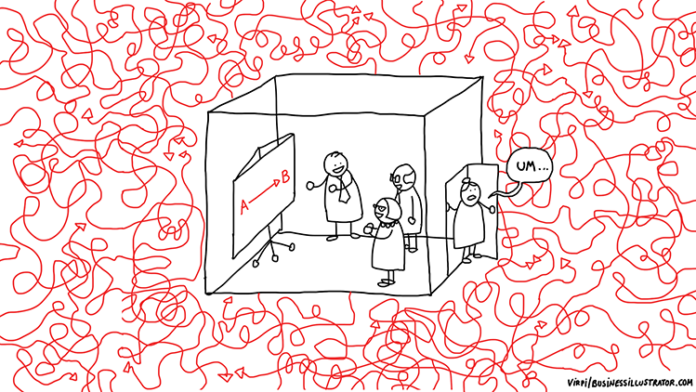Complexity characterizes the behavior of a system or model whose components interact in multiple ways and follow local rules, meaning there is no reasonable higher instruction to define the various possible interactions.
The term is generally used to characterize something with many parts where those parts interact with each other in multiple ways, culminating in a higher order of emergence greater than the sum of its parts. The study of these complex linkages at various scales is the main goal of complex systems theory.
Science as of 2010 takes a number of approaches to characterizing complexity; Zayed et al reflect many of these. Neil Johnson states that “even among scientists, there is no unique definition of complexity – and the scientific notion has traditionally been conveyed using particular examples.” Ultimately Johnson adopts the definition of “complexity science” as “the study of the phenomena which emerge from a collection of interacting objects”.
The approaches that embody concepts of systems, multiple elements, multiple relational regimes, and state spaces might be summarized as implying that complexity arises from the number of distinguishable relational regimes (and their associated state spaces) in a defined system.
One of the problems in addressing complexity issues has been formalizing the intuitive conceptual distinction between the large number of variances in relationships extant in random collections, and the sometimes large, but smaller, number of relationships between elements in systems where constraints (related to correlation of otherwise independent elements) simultaneously reduce the variations from element independence and create distinguishable regimes of more-uniform, or correlated, relationships, or interactions.
What is the purpose of complexity?
The purpose is to report important advances in the scientific study of complex systems. Complex systems are characterizes by interactions between their components that produce new information — present in neither the initial nor boundary conditions — which limit their predictability.
How many types of complexity are there?
Different kinds of Kolmogorov complexity are studying: the uniform, prefix, monotone, time-bound Kolmogorov, and space-bound Kolmogorov.
How do we measure complexity?
A simple way of quantifying on a structural basis would be to count the number of components and/or interactions within a system.
What is complexity factor?
A number that shows the level of complexity to any situation. It comes from the parts, type of connections, unknowns, and uncertainty.
How do you calculate complexity factor?
The values are multiplying by the weight values and the total TF is determine. Next, the TCF is calculate: TCF = 0.6 + (TF/100)
How do you calculate technical factor?
Technical factor (TCF) is calculate by multiplying the value of each factor (T1-T13) in Table 3 by its weight and then adding all these numbers to get the sum refer the T-Fac- tor. Finally, the following formula is apply to: TCF=0.6+(0.01*T-Factor).
How is application complexity calculated?
To calculate the cyclomatic complexity of our code, we use these two numbers in this formula: M = E − N + 2 . M is the calculated complexity of our code (Not sure why it’s an M and not a C .) E is the number of edges and N is the number of nodes.
How do you measure project complexity?
It is determine in my organization by evaluating project attributes using the seven criteria listed below:
- Life-cycle size for cost,
- Life-cycle duration for schedule,
- Project organization,
- Technology readiness,
- Risk,
- Visibility, and.
- Authorization basis.
How case point approach is use for calculating efforts explain?
Use Case Points (UCP) is an estimation method that provides the ability to estimate an application’s size. And effort from its use cases. Based on work by Gustav Karner in 1993, UCP analyzes the use case actors, scenarios and various technical. And environmental factors and abstracts them into an equation.





